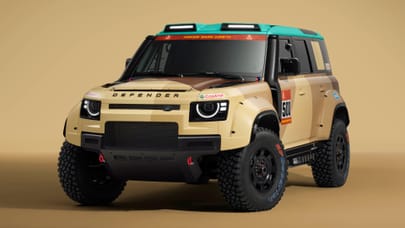
Ford Bronco vs Wrangler vs Defender: the numbers
The Bronco is back. Time to bring out the spreadsheet


We’ll only be able to compare the Bronco with other 4x4s – to say whether it’s better or worse – when we get to drive one. Numbers don’t tell the whole story – nothing like it – but they’re as good a place as any to start. So Internet, click forth to see how the new Ford Bronco (click here for the full story) compares to some of the world’s most capable off-roaders when you’ve got nowt but a spreadsheet to go on.
To keep things consistent, unless otherwise stated we’re talking about the most serious off-road ready version of any 4x4 we mention. The best numbers quoted. For the Ford Bronco, that’s the either the Badlands or Wildtrak. They’re the ones you’ve seen in all the pictures, usually with the ‘Sasquatch Package’ (standard on Wildtrak, optional on Badlands) giving 35-inch tyres and all the sexy hardware you’ve read about. For the Jeep Wrangler it's the Rubicon, while the Land Rover Defender is just as capable whatever spec you go for.
Advertisement - Page continues belowSize

The new Bronco is big, yes, but not outrageously big. In most respects it’s a bit bigger than a Jeep Wrangler but, surprisingly, a bit smaller than a Land Rover Defender. In Badlands trim the two-door is 4,440mm long, 1,874mm tall and 1,938mm wide (with the mirrors folded). A Bronco Wildtrak is a fair bit wider and taller because of those 35-inch tyres you absolutely must spec. Badlands gets 33-inch diameter tyres as standard.
A two-door Wrangler Rubicon, meanwhile, is 4,237mm long, 1,868mm tall and 1,875mm wide, while a Land Rover Defender 90 (with the optional air suspension) is 4,583mm long, 1,969mm tall and 2,008mm wide. Same story with the four-door versions – the Wrangler is a tiny bit smaller, and the Defender is mostly bigger.
Engines

From the get-go the Bronco is available with either a 2.3-litre four-cylinder or 2.7-litre six-cylinder turbocharged petrol engine. The former makes 270bhp and 310lb ft, while the latter (which is actually twin-turbocharged) gets 310bhp and 400lb ft.
In the UK the Wrangler comes with a 2.0-litre petrol (270bhp, 295lb ft) or 2.2-litre turbodiesel (197bhp, 332lb ft). In the States you can have the little petrol, but the diesel option is an altogether meatier 3.0-litre V6 making 260bhp and 442lb ft, plus there’s a 3.6-litre petrol V6 with 285bhp and 260lb ft. A V8 might be coming, too.
Both the 2.0-litre and 2.6-litre petrols get optional mild-hybrid tech, while the Bronco makes do without any kind of electrification (at least for now).
The Defender, meanwhile, gets a 296bhp 2.0-litre petrol and 395bhp mild-hybrid 3.0-litre petrol, plus in Europe a couple of popular 2.0-litre diesels.
Advertisement - Page continues belowTransmissions

The Defender gets an eight-speed auto whatever engine you go for. With low-range, naturally. The Jeep is available with a six-speed manual or eight-speed auto, while the Bronco gets a seven-speed manual (six normal ratios plus a special ‘crawler’ gear) or a ten-speed automatic.
Wading Depth

A Bronco with 35-inch tyres can wade through 851mm of water. We’d suggest keeping the doors attached if you’re planning on trying out Ford’s claims. The Defender is the daddy here – height-adjustable air suspension helps it swim through up to 900mm of water. Meanwhile, Jeep claims the Wrangler can ford a 760mm deep river.
Ground Clearance

More ground clearance is usually better. The Bronco offers up to 295mm – more than the Wrangler (274mm at most) and Defender (291mm with the air suspension in off-road mode). Take away the Bronco’s 35-inch tyres, though, and you only get 213mm.
Attack/Departure/Breakover Angles

You lot probably know this, but for those that don’t, allow us to explain what exactly these measurements mean. Attack angle is how steep an angle a car can tackle without scraping its nose on the ground. Supercars have tiny attack angles, which is why nose lift is a thing. Departure angle is the exact opposite – how steep a slope you can descend without catching your back bumper on the ground as you level out. Breakover angle, meanwhile, is how much of a hump you can drive over without bottoming out.
Anyway – despite the Bronco’s massive 35-inch tyres, the Defender wins round one, with a breakover angle of 28 degrees for the 110 and 31 degrees for the 90. (Bronco: 26.3 and 29 degrees respectively. Wrangler: 22.6 and 27.8 degrees respectively). And round two, with a departure angle of 40 degrees (37.2 for the Bronco, 37 for the Wrangler).
The Wrangler narrowly takes round three – its 44 degree attack angle beats both the Bronco (43.2) and the Defender (38).
Advertisement - Page continues below
You can buy a Defender or Wrangler in Britain. But you cannot buy a Bronco. You could stick one on a boat, though. Prices start at $28,500 (around £22,500), but the kitted-out Badlands and Wildtrak are $42,095 (£33,300) and $48,875 (£38,600) respectively.
In the UK the Wrangler starts at £41,525, rising to £50,815 for the Rubicon. Much cheaper in the US – from $28,295 (£22,370) to $38,695 (£30,600) for a Rubicon.
The Defender? In the UK prices start at £40,330, or $49,900 in the States, but get busy with the options list and you could end up spending over £90,000 ($114,000).
Trending this week
- Car Review
BMW 1 Series







